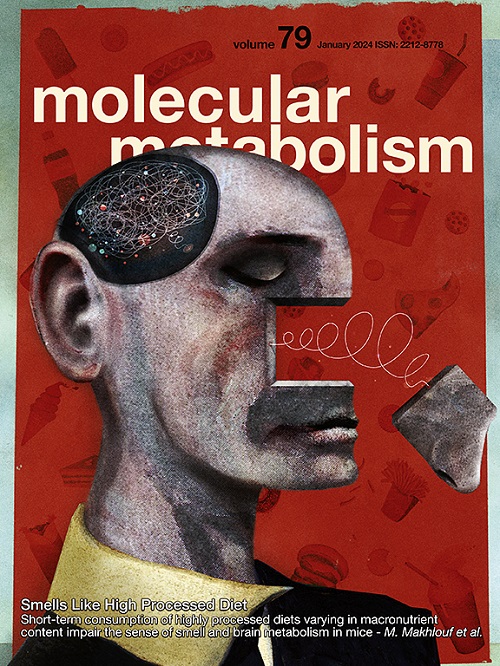脑干BBSome以状态依赖的方式调节葡萄糖稳态和瘦质量。
IF 6.6
2区 医学
Q1 ENDOCRINOLOGY & METABOLISM
引用次数: 0
摘要
目的:肥胖通过改变脑功能破坏代谢稳态。下丘脑纤毛和相关蛋白,如BBSome,一种由八种Bardet-Biedl综合征(BBS)蛋白组成的蛋白复合物,与代谢调节和疾病有关。在这里,我们研究了脑干纤毛和BBSome对能量平衡和葡萄糖稳态的意义。方法:用免疫荧光和共聚焦成像评估初级纤毛,用单细胞RNA测序分析脑干神经元转录组。Ift88或Bbs1 phox2b特异性缺失小鼠在对照或高脂饮食下进行了研究。代谢试验、胰岛素信号、神经记录和病毒技术被用来评估纤毛或Bbs1破坏的影响。结果:我们发现饮食诱导的肥胖小鼠孤束核的初级纤毛长度增加。单细胞RNAseq结果显示,纤毛相关基因在表达Phox2b的谷氨酸能背迷走神经复合体(DVC)神经元中富集。Phox2b神经元(Phox2bCre/Ift88fl/fl)的原发性纤毛缺失在青春期引起轻度体重减轻,但不改变成年期的代谢稳态。接下来,我们用Phox2bCre/Bbs1fl/fl小鼠研究脑干BBSome,这些小鼠表现出青春期瘦体重增加减少,但成年体重正常。令人惊讶的是,这些小鼠出现葡萄糖耐受不良和空腹血糖升高,与肝脏交感神经和副交感神经活动的对比变化有关,表明自主神经失衡是葡萄糖失调的原因。靶向bbd: DVC的一些破坏复制了空腹血糖的升高,化学发生DVC Phox2b神经元的激活减轻了糖耐量试验中的高血糖,抑制了肝脏交感神经的活动。有趣的是,饮食诱导的肥胖Phox2bCre/Bbs1fl/fl小鼠表现出较低的瘦体重和葡萄糖耐量的矛盾改善,尽管胰岛素抵抗,这表明脑干BBSome在肥胖相关的代谢功能障碍中起着复杂的作用。结论:我们的研究结果强调了脑干调节代谢稳态的新机制,以及初级纤毛和BBSome在葡萄糖调节和瘦体重中的独特作用。本文章由计算机程序翻译,如有差异,请以英文原文为准。

The brainstem BBSome regulates glucose homeostasis and lean mass in a state-dependent manner
Objective
Obesity disrupts metabolic homeostasis through changes in brain function. Hypothalamic cilia and associated proteins, such as the BBSome, a protein complex composed of eight Bardet-Biedl syndrome (BBS) proteins, have been implicated in metabolic regulation and disorders. Here, we investigated the significance of brainstem cilia and the BBSome for energy balance and glucose homeostasis.
Methods
Primary cilia were assessed by immunofluorescence and confocal imaging, and brainstem neuron transcriptomes were analyzed using single-cell RNA sequencing. Mice with Phox2b-specific deletion of Ift88 or Bbs1 were studied under control or high-fat diets. Metabolic tests, insulin signaling, nerve recordings, and viral techniques were used to evaluate the impact of cilia or Bbs1 disruption.
Results
We found that diet-induced obese mice display increased primary cilia length in the nucleus tractus solitarius. Single cell RNAseq revealed that cilia related genes are enriched in glutamatergic dorsal vagal complex (DVC) neurons expressing Phox2b. Primary cilia deletion in Phox2b neurons (Phox2bCre/Ift88 fl/fl) caused a mild weight reduction during adolescence without altering metabolic homeostasis during adulthood. We next investigated the brainstem BBSome using Phox2bCre/Bbs1fl/fl mice, which exhibited reduced adolescent lean mass gain but normal adult body weight. Surprisingly, these mice developed glucose intolerance and elevated fasting glucose associated with contrasting changes in hepatic sympathetic and parasympathetic activity, pointing to autonomic imbalance as a cause of glucose dysregulation. Targeted BBSome disruption in the DVC replicated elevations in fasting glucose and chemogenetic DVC Phox2b neuron activation attenuated hyperglycemia during glucose tolerance test and suppressed hepatic sympathetic nerve activity. Interestingly, diet-induced obese Phox2bCre/Bbs1fl/fl mice exhibited lower lean mass and a paradoxical improvement in glucose tolerance despite insulin resistance, suggesting a complex role for the brainstem BBSome in obesity-associated metabolic dysfunction.
Conclusions
Our findings highlight novel brainstem mechanisms regulating metabolic homeostasis and distinct roles for primary cilia and the BBSome in glucose regulation and lean mass.
求助全文
通过发布文献求助,成功后即可免费获取论文全文。
去求助
来源期刊

Molecular Metabolism
ENDOCRINOLOGY & METABOLISM-
CiteScore
14.50
自引率
2.50%
发文量
219
审稿时长
43 days
期刊介绍:
Molecular Metabolism is a leading journal dedicated to sharing groundbreaking discoveries in the field of energy homeostasis and the underlying factors of metabolic disorders. These disorders include obesity, diabetes, cardiovascular disease, and cancer. Our journal focuses on publishing research driven by hypotheses and conducted to the highest standards, aiming to provide a mechanistic understanding of energy homeostasis-related behavior, physiology, and dysfunction.
We promote interdisciplinary science, covering a broad range of approaches from molecules to humans throughout the lifespan. Our goal is to contribute to transformative research in metabolism, which has the potential to revolutionize the field. By enabling progress in the prognosis, prevention, and ultimately the cure of metabolic disorders and their long-term complications, our journal seeks to better the future of health and well-being.
 求助内容:
求助内容: 应助结果提醒方式:
应助结果提醒方式:


